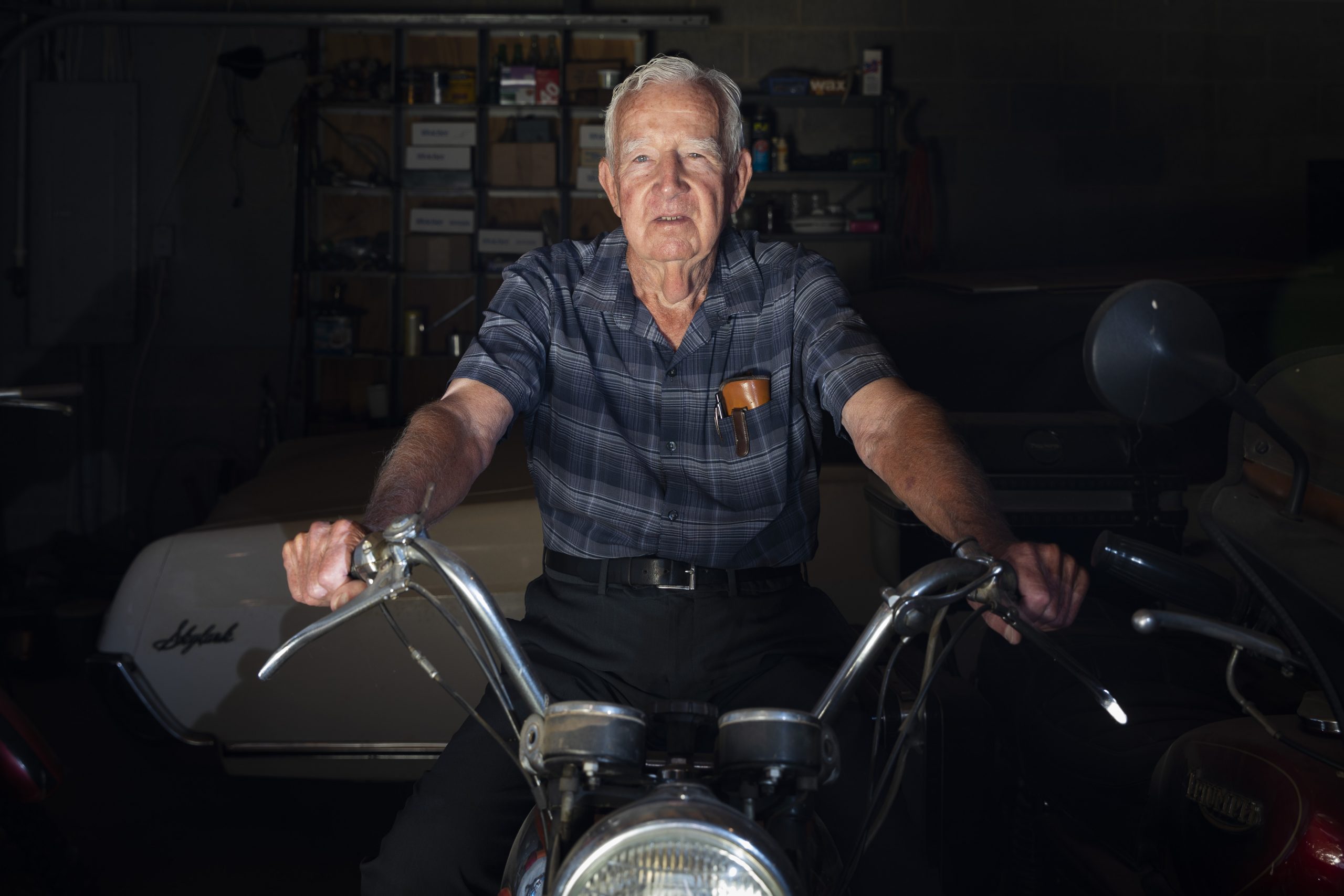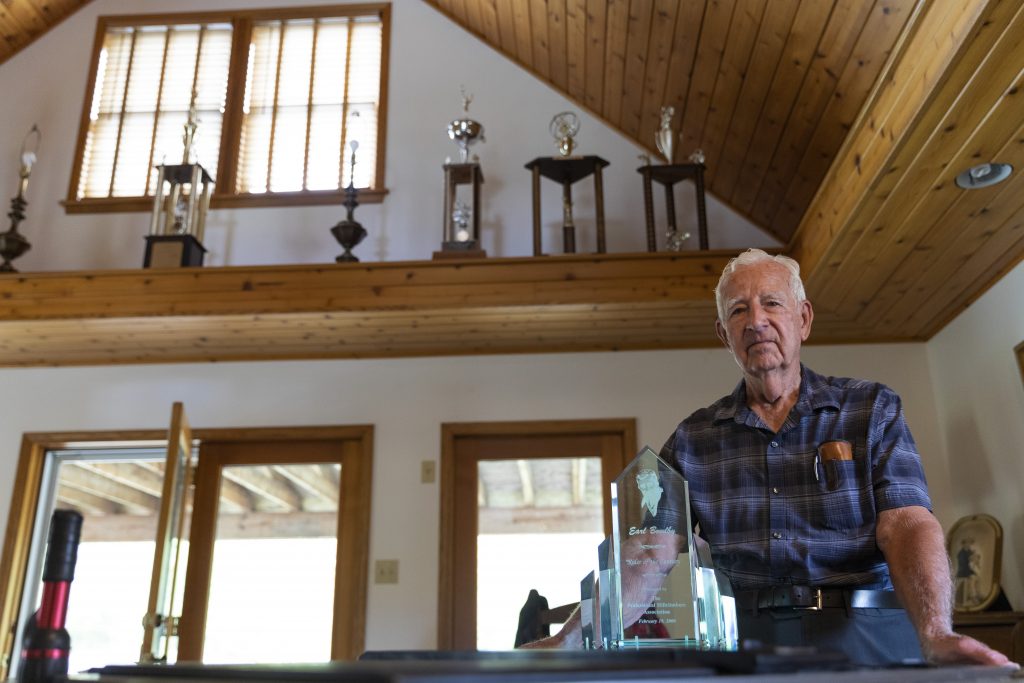
Record-Setting Hillclimber Early Bowlby Calls Logan Home
A wooden cottage sits atop a gravel driveway. A deck on its outer end faces a wall of trees blocking light from the roadway. Near the ravine, a shed sits full of motorcycle and tractor parts, covered in overgrown foliage and a Suzuki sign.
The garage, on the left, is filled with motorcycle parts, ranging from spark plugs to 8 ounce “Old Reliable” Chain Oil that in the ‘40s went for $1.95.
“That oil is about as old as I am,” Earl Bowlby says.
This view is an everyday sight and reminder for national hill climbing legend Earl Bowlby.
Bowlby, 86, of Logan, was at the forefront of the hill climb industry. Hill climbing is a motorsport where motorcyclists attempt to ride up steep hills in the fastest time possible. Starting his amateur hill climbing career at 28. He began his professional career in 1966.
Bowlby’s first race was the amateur hill climb in at the Children’s Home in Lancaster. He hopped on his tiny single singular BAS “star fire” roadster. Staring up the steep, dirt hill, all he could think was, “How fast can I get up there and how am I going to do it?”
He started the engine, revved the motorcycle and let loose. Dirt flew up in the air, past his back tire and the exhaust from his motor followed him up the path. Bowlby made it halfway up the hill before his scout fell back to the bottom.

Bowlby’s second time hill climbing is a far different story. He made it up the hill and continued to do so for over 40 years.
The continued pursuit of hill climbing is euphoric for Bowlby: the test of not only how fast can one get up a hill but also how can one make it still up the hill in one piece. The competition, companionship and love of motorcycles made Bowlby who he is today: a man passionate about the craft of hill climbing.
___
UPBRINGING
Bowlby’s love for motorcycles began in high school. When he was a senior at Logan Central School, he chose auto maintenance for his diversified occupation, a program where students work half the school day in their field of choice.
Bowlby worked at Tansky Motors, where he patched up old cars in the body shop to be resold. He found not only his interest in cycles at the shop, but also his friends who hill climbed: the Clark brothers. The Clark brothers needed motorcycle parts for their hill climbing, which is where they met Bowlby. This sparked Bowlby’s inspiration of hill climbing.

Bowlby’s parents had mixed reactions when they found out he started hill climbing. His father was excited to see him hill climb when he could. His mom was scared of seeing her son go up those steep, rock-filled hills, with only a helmet and a leather jacket for protection.
“There was no injury I couldn’t walk away from,” Bowlby says.
___
PROGRESSION
As Bowlby started competing in more hill climbing events, he constantly needed to restock and upgrade his bike.
The closest shop to get the parts needed to upgrade his bike was in Lancaster, a 30-minute drive for Bowlby. He had the knowledge of what parts to get it and how to maintain his bike. With this intuition, he decided to take a chance.
Bowlby sent in a letter to the BSA franchise in New Jersey and opened his own dealership in Hocking County in 1960 when he was 27 years old.
Bowlby started winning national tournaments, over 80, in fact. He fondly remembers 1984, the year he won the crown jewel for hillclimbers: the triple crown. The triple crown is when a hillclimber wins a grand national, a national and a Canada national. He also set a Michigan record of 4.71 seconds.
“No one’s ever done that,” Bowlby says.
___
RETIREMENT
Bowlby retired from his hill climbing career in 1990, after having another successful national hill climbing season. He wanted to build his home, make a portable sawmill and build a log cabin near his house.
But no great hill climbers are without their biggest fan. Bowlby’s greatest fan was his wife, Shirley Jean Bowlby. Jean took an encyclopedia-sized interest in her husband’s hill climbing career. She kept records of his wins, hill climbing tournament dates, magazine clippings, magazine covers and interviews. Jean even kept postcards of where they traveled throughout the country.

One trip Bowlby remembers most is their trip to Alaska. In 1988, Bowlby and Jean visited the state for three weeks to sight-see. Alaka’s Yellow Knife northwest territories are filled with what Bowlby loves: dirt roads, trees lining roadsides and low-speed-limit roads.
He’s living the dream, even if some of his visions weren’t completed. The sawmill is not finished, nor is the log cabin. What he does have, though, is history at home. Trophies that reflect off the windows in the house, motorcycles in his garage where American Motorcycle Association magazines sit tucked away in filing cabinets.
“There was no injury I couldn’t walk away from,”
Early Bowlby
The American Motorcycle Association Museum has remembered the history of Earl Bowlby by showcasing his 1967 BSA 650. A heavily modified machine he built in 1976, Daniel Clepper, collections manager, says.
“Modifications to the machine include boring it out from 654cc to 782cc displacement, running special Venolia pistons, and an extended subframe and rigid swingarm that Bowlby fabricated himself,” Clepper says. Bowlby took the BSA to the 1976 Nationals in Muskegon, Michigan, where he set the 4.71 time record.
Earl Bowlby’s legacy continues to live on, one spark plug at a time.